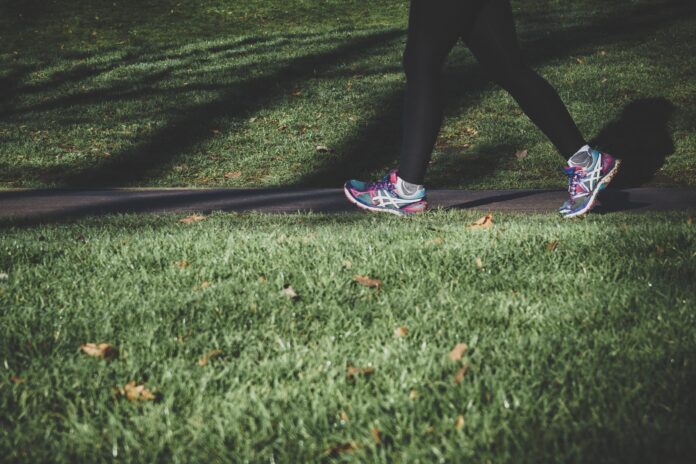
“If you are in a bad mood, go for a walk. If you are still in a bad mood, go for another walk.” ― Hippocrates
YOU’VE HAD a hard day at work. You’re stressed, tired, and frankly not interested in doing much of anything. Or perhaps you’re out of work just now, bored, frustrated, and running out of options when it comes to paying bills. Either way, there’s something at your disposal that costs nothing, is a natural anti-depressant, lowers cholesterol and high blood pressure, and releases natural endorphins or feel-good hormones in your brain. Do you know what it is?
This is no wonder drug with unpleasant side-effects. It’s the simple act of walking.
Precisely because it’s so simple, we often underestimate just how effective it can be in maintaining and restoring good health. Remember, we are designed to move about. Not necessarily at high speeds or in very intense bursts, but just to move. Our lymph system relies entirely on movement to function well, as it has no valve system to move it about the way blood does. Given that the lymphatic system is the master of our immunity, we definitely want to look after it.
Our joints are absolutely designed for movement, in all manner of directions. Very often, it’s lack of activity which leads to stiffness and pain.
Even those with joint problems such as arthritis often feel better after gentle movement like walking, as this simple activity helps synovial fluid to coat the joints and keep them in good condition.
Even if you haven’t walked much in years, the advantage is everyone knows how to do it. It doesn’t require any particular classes or skills. It’s sufficient to make sure your posture is relatively good and your gait is well-balanced, so that you are not putting any one area under undue stress.
Start at a steady pace, particularly if you’re very out of condition. Choose a simple enough route you know you can complete easily and repeat this route until it becomes a bit too easy.
To gain cardiovascular benefit from any activity, you need your heart rate to increase, so if you are too ‘comfortable’, you need to up the pace somewhat. This could be by walking a little faster, taking on a longer route, or including a few inclines which require a little more exertion.
This time of year is the perfect time to get into walking, as the autumn leaves fall and crunch beneath your feet.
One of the huge advantages of walking is the benefit to your mood. The mechanical act of putting one foot in front of the other may not seem like it is achieving much but, as it engages both sides of the brain, it really helps to balance brain activity.
If you are normally using the analytical, logical part of your brain more in your work, walking helps to activate the creative, lateral side of your brain. Likewise, if you ordinarily rely heavily on the creative side of your brain, walking helps to wake up the organisational side of your brain.
More importantly though, walking is a great time to process thoughts and ideas. If you’ve been mulling over a particular situation while sitting at your desk or slumped on the couch, you may well think much more clearly once you get moving.
There’s the obvious advantage of increased oxygen to the brain once we’re more active, which makes for more efficient thought processes. But there’s also the fact that activity releases all-important endorphins. These feel-good substances put us in a much more positive mind-set.
Most decisions are reached more effortlessly in this positive state of mind than in a negative, stressed, shut-down state. The proof of this fact comes from those who have used exercise such as walking to treat and manage depression and other mental health problems. The benefits have sometimes surpassed those derived from taking antidepressants (though those taking antidepressants should always consult with their GP before making any decisions about their medication, of course).
If you are suffering from depression, just the thought of going for a walk may seem beyond you. But if you can cover any distance at all, even just up and down the hall, you’ve made a start.
The trick then is to try to make it a regular part of your routine.
There are obvious advantages to walking if you are trying to tone up too, of course, but it’s what’s going on under the surface that really matters.
Increased activity makes a huge difference to issues such as cholesterol levels and high blood pressure. You’ll get results you would never get with diet alone by adding in some activity, as well as making dietary changes.
This applies as well to obesity – whether childhood obesity or adult – and of course diabetes too. A combination of increased activity and dietary adjustments gets profound changes happening for those suffering from diabetes. Don’t forget diabetes is largely related to lifestyle, so it just makes sense to reintroduce good habits to your lifestyle.
If your whole family is suffering from obesity, diabetes, or borderline diabetes, it would be a wonderful idea to get everybody out and about. Maybe turn off the TV or computer for an hour or two and get outdoors instead.
Even if you can only go for a stroll in the local park, it will make a huge difference to your health prospects down the line. Don’t underestimate the power a few steps can have. It’s always better to lead by example, so going as a group provides support and encouragement.
Make a start, however small. Walk to the shop instead of taking the car. Use the stairs instead of the lift. Stroll to visit granny if she lives close enough. Arrange to meet a friend for a walk instead of a pint or piece of cake.
There is great sociability in walking, but equally, it can be a great time for contemplation if you go on your own. It’s probably the most flexible activity you could choose for that reason.
There’s no membership required and you can change the route as often as you like. You get to see beautiful sunsets, hear birds singing, and perhaps observe the phases of the river too, depending on your route.
What’s not to like? Go on, get out there!









